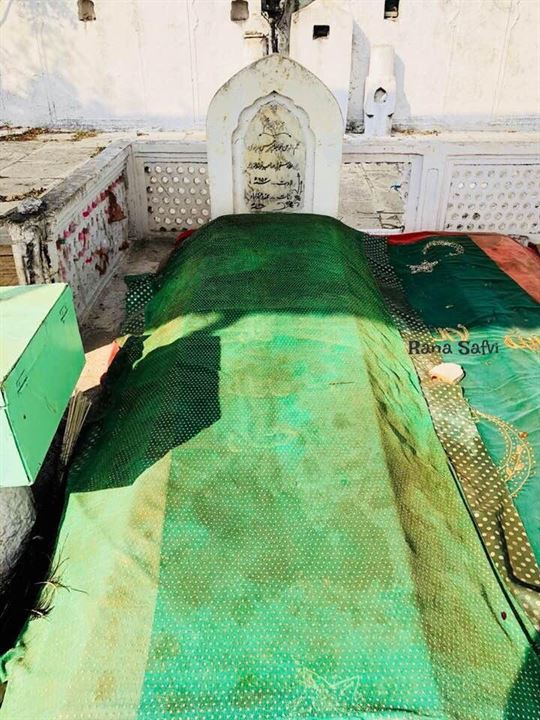In Khuldabad I recite Fatiha on the simple grave of Amir Hasan Sijzi the writer of Fawaidul Fuad.
A contemporary of Hazrat Amir Khusrau and just as great
https://www.thehindu.com/opinion/columns/sufism-in-the-simplest-terms/article22920256.ece
Hazrat Nizamuddin Auliya, who lived from 1238 to 1325, is an extremely popular Sufi saint of the Chishti Order. The Nizamuddin Dargah (mausoleum) in New Delhi is visited by thousands every week. He had two disciples, both well-known poets of their time: Amir Khusrau and Amir Hasan Sijzi. Next to Hazrat Nizamuddin Auliya’s shrine lies the shrine of Hazrat Amir Khusrau. It is called the Choti Dargah. This is the story of the shrine of Auliya’s other disciple, Amir Hasan Sijzi.
On a recent trip to Aurangabad, I visited Khuldabad, also referred to as the valley of saints. Most people know it as the burial place of the Mughal emperor Aurangzeb, but there is much more to the area. There is a reason why Aurangzeb had asked to be buried there.
The valley of saints
When Sultan Muhammad bin Tughluq ordered in 1327 that his capital be shifted from Delhi to Deogir, which he named Daulatabad, he instructed the elites, nobles, officers, common men, and even the saints to shift with him.
The Sufi saints, 1,400 of them, decided to settle in an area near Daulatabad. The shrines of these saints dot the area, which is why that place was initially called Rauza (shrine). After Aurangzeb’s burial it was renamed Khuldabad as he was given the posthumous title of khuld-makani (hw who resides in paradise). Famous saints such as Shah Raja Qattal, Shaikh Burhanuddin Gharib, Shaikh Muntajibuddin and Aurangzeb’s spiritual master, Shaikh Zaynuddin Shirazi, are buried there.
It was while I was researching why this place is called the valley of saints that I found that Amir Najm al-Din Hasan Dihlavi ibn Khwaja Ala al-Din Sistani, commonly known as Amir Hasan Sijzi or Hazrat Amir Hasan Dehlvi, was also buried there. He too had been ordered to leave Delhi for Daulatabad, and was never to return.
If Amir Khusrau captured Hazrat Nizamuddin Auliya’s teachings in his songs and poetry, Amir Sijzi did the same in the famous compilation titled Fawa’id-al-Fu’ad, which contains the literary discourses of Hazrat Nizamuddin Auliya. Unlike Amir Khusrau who became his disciple when he was around eight years old, Amir Sijzi became Auliya’s disciple quite late in life, when he was already an established poet and called the Saadi-e-Hind. Amir Sijzi was born in Badaun in Uttar Pradesh in 1254 and died in Daulatabad in 1337.
Saiyid Zaheer Husain Jafri, professor at the department of history at Delhi University, says that Fu’ad was the first book of its kind in India. It was for the first time that anyone had written about the day-to-day interactions, reactions and teachings of a Sufi Shaikh in his khanqah. He says: “In this book, you find the principles of Sufism being talked about in the simplest of terms by the great Shaikh, and we also see that every section of society is represented. The Shaikh is not only talking to the elites but to the common man as well. It’s not that Shaikhs didn’t speak earlier, but a mature scholar, recognising the value of these discourses, recorded it for posterity. The entire book is in the form of conversations supported by examples. It is a lively speech that captures the reader’s imagination.” It is also important because the saint himself checked the account for veracity. Very simply written, this book is an important historical, social and literary document as it records contemporary life and society.
Professor K.A. Nizami has written in his preface to the English translation of Fu’ad by Bruce Lawrence: “It soon found a distinctive place in Muslim mystic literature.” In fact, Amir Khusrau offered to exchange all his works for it.
The shrine and some sugar
When I reached Khuldabad, I had to ask many people about this shrine. I was told to look out for a big gate with an old man sitting in front of it. This was to the west of Khuldabad and it seemed as though not many people visit this place. I found the old man, the caretaker, sitting in front of a big gate, which he opened when my car stopped there. He took me inside and I offered my prayers.
It is believed that the original copy of the Fawa’id-al-Fu’ad is buried with Amir Hasan Sijzi as per his will. The caretaker told me that children who can’t talk are brought to this shrine and given sugar, which is believed to give them the power of speech. On hearing that I was a writer, the caretaker offered me some sugar to sweeten my pen. I pray that it works.

